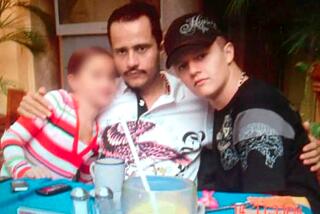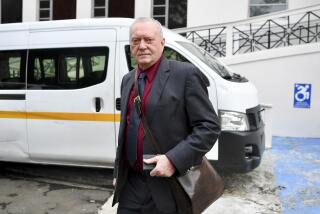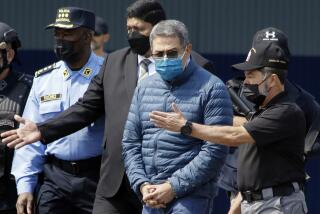2 Noriega Co-Defendants Found Guilty : Narcotics: They are convicted of conspiracy and intent to distribute cocaine. A lawyer for Panama’s ex-dictator says his case is not affected.
- Share via
MIAMI — Two co-defendants of deposed Panamanian ruler Manuel A. Noriega were found guilty Tuesday of conspiracy and intent to distribute 732 pounds of cocaine they hoped to smuggle into the United States.
A federal jury of 10 women and two men found Miami real estate salesman Brian Alden Davidow, 29, and Colombian yacht broker William Saldarriaga, 46, guilty after deliberating for less than five hours.
The pair were charged with attempting to smuggle the drugs into the United States in 1986 aboard a 46-foot luxury boat called the Krill. In exchange for the drugs, prosecutors charged, the defendants--with an assist from Noriega--helped deliver 1,000 M-16 rifles to Colombian guerrillas.
Davidow and Saldarriaga face fines of up to $50,000 and prison terms of up to 30 years. They are to be sentenced May 14.
Richard A. Sharpstein, attorney for Davidow, the only American among 15 Noriega co-defendants, attributed the guilty verdict to “the media circus going on around the case.” Jurors, he said, “were overwhelmed by the attention given to Noriega during the trial.”
Indeed, the trial was once billed as a preview of the U.S. government’s case again Noriega, who was seized during the December, 1989, U.S. invasion of Panama and brought to Miami to face charges that he accepted $4.6 million from Colombia’s Medellin cartel to turn Panama into a sanctuary for drug runners.
One of the 11 felony counts against Noriega also involves the Krill incident. Noriega’s name was invoked often during the three weeks of testimony in U.S. District Court, and a blow-up of his face--from a photo found in the Krill’s stateroom--was introduced as evidence by the government and then propped in the courtroom facing jurors.
But Frank A. Rubino, Noriega’s chief counsel, said the verdicts would have no bearing on Noriega’s trial, scheduled to begin June 24. “Honestly, it doesn’t mean a thing,” he said. “With respect to Gen. Noriega, he was only brought in by implication. I’m not real upset about it.”
The government’s case against Saldarriaga and Davidow, as is the case against Noriega, was founded on testimony from a rogue’s gallery of nether world drug smugglers, most of whom are benefitting from their cooperation with the government. Of the 15 persons indicted with Noriega in 1988, four have entered guilty pleas in exchange for testimony, and eight others are fugitives.
A host of colorful characters took the witness stand during the trial, some to swear that Saldarriaga confessed to the crimes while in prison, and others to place both defendants at a meeting in Panama City where the Krill voyage was planned. The yacht, loaded with the cocaine, was intercepted by police at a Colombian island.
Perhaps the most damning witness proved to be another Noriega co-defendant, Amet Paredes, 29-year-old son of a former Panamanian military commander and onetime Noriega rival.
After a plea bargain deal with the government that assures him of spending no more than 10 years in jail, Paredes told jurors he attended the planning session for the drug swap and heard Noriega join in by speaker phone to approve the details.
By far the most dramatic incident of the trial happened 12 miles from the federal courthouse, when on Feb. 27--the eve of the first day of testimony--the man who was to be the government’s star witness was killed in a mysterious car crash. Ramon Navarro, a flashy, 41-year-old drug dealer turned government informant, was found dead behind the wheel of his red 1989 BMW after the car left the road, plowed through a wooden fence and smashed into an electrical transformer.
Police have said there is nothing to suggest foul play in Navarro’s death, but it remains under investigation.
More to Read
Sign up for Essential California
The most important California stories and recommendations in your inbox every morning.
You may occasionally receive promotional content from the Los Angeles Times.










